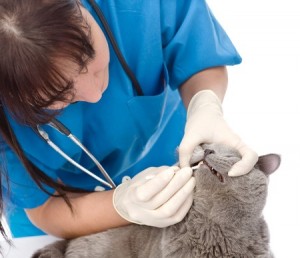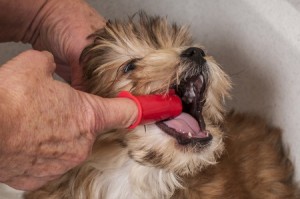 Good oral health is important for everyone, including your cats and dogs. Mouth, gum, and teeth problems can cause systemic health issues, and even be potentially fatal. So brushing your pet’s teeth regularly is a basic necessity for their health. This is a simple “How To…” so that you can get your pet used to brushing.
Good oral health is important for everyone, including your cats and dogs. Mouth, gum, and teeth problems can cause systemic health issues, and even be potentially fatal. So brushing your pet’s teeth regularly is a basic necessity for their health. This is a simple “How To…” so that you can get your pet used to brushing.
Good oral health will keep your pet happy and healthy. He won’t struggle to eat because of mouth pain, and his entire system will be so much healthier. You want to have your furry pal around for a long time, and brushing his teeth with regularity and every day, will add years to his life and love and fun to yours.
There are many products created especially for animals. And that includes flavored toothpaste and soft toothbrushes. These can be found at your veterinarians’ office and other places you shop for pet supplies. The toothpaste flavors are beef, tuna, and malt. These special pastes have enzymes that decrease plaque, the soft form of tartar.
Find products that suit both you and your dog. Toothbrushes come in a variety of styles, including one that fits over your finger. But if your dog won’t tolerate any of them, you can use your finger with some gauze covering it. Toothpastes also come in different flavors so try them and see which one your dog likes. Remember that your dog is going to be swallowing the paste so get one especially for dogs and never use human toothpaste.
First of all, do things that get your pet used to having their muzzle and mouth manipulated. Take it slow so they are not scared or overwhelmed by your behavior. And find some kind of reward that you can give them so he associates something fun with the brushing process.
To get your cat or dog used to being handled in this way, try this exercise. Keep a loved treat in your hand and gently put your other hand over the animals’ muzzle, and gently, lift their lips up, for about 3 seconds, exposing his teeth. Give them the treat. Repeat this about seven or eight times. Do these exercises two times a day for a few  days, slowly increasing the time you lift his lips. Don’t even attempt to brush his teeth.
days, slowly increasing the time you lift his lips. Don’t even attempt to brush his teeth.
Do the above exercises again, but now hold the mouth open for a few seconds and give a treat. Repeat this
exercise as you did above over a period of days, each day increasing the amount of time you hold the dog’s mouth open. Always reward his patience with a treat. Once you have held your cat or dog’s mouth open for at least ten seconds, he is ready for the brush, and so are you.
You are going to get your pet used to the brush and toothpastein increments as you did with his being handled. Without opening the mouth, just lift the lips and gently brush the outside of the teeth and gums for about 3 seconds, starting with the upper outer teeth since most of the tartar starts there. Reward with a treat. Increase the length of time you brush a few seconds at a time, always giving a treat when you’re done. After a while you will be able to brush all the outside teeth surfaces in one go.
Now you are ready to brush the interior surfaces of his teeth and gums. Open his mouth as you did above and gently brush the teeth interiors for about 3 seconds, and give a reward. Practice this twice a day, increasing the length of time you brush incrementally. Always give a treat as a reward for tolerating the brushing. And praise your pet. Do this until you are able to brush all the interior surfaces of teeth and gums.
Always brush twice a day, and never for longer than five minutes at a time. And reward your pet each time. He should be getting used to the brushing process by now.
Getting puppies and kitten used to you having fingers in their mouths at a young age helps later on when you have to brush the adult teeth (there is no need to brush the baby teeth as they will all be gone by 6 mo. of age). Take your pet to the vet regularly, and have his mouth examined. Giving him kibble and not just canned, soft food, is helpful at preventing the formation of plaque on the teeth. You can also let him have CET chews, and other “dental” chews to keep the plaque at bay. Making sure you give your pet regular tooth maintenance can save you a lot of time and money by not needing professional teeth cleaning.

 Posts RSS
Posts RSS

WORKING HOURS:
Monday-Friday 8:00am - 5:00pm
Saturday 8:00am - 12:00 noon